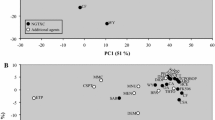Abstract
Background
This study seeks to estimate whether a chemical has carcinogenic potential; and if it has carcinogenic activity, its carcinogenic efficacy in humans and experimental animals in terms of oral and inhalation slope factors.
Objective
Target chemicals were selected by literature search using Google Scholar, PubMed, ScienceDirect, etc., among the chemicals set by the Ministry of Employment and Labor in Korea as existing chemicals, and the CSF of each chemical was determined using various sites and programs, including EPA Comptox Dashboard and VEGA Hub QSAR (ver. 1.2.3). The CSF value of each chemical obtained using the Comparative Toxicogenomics Database (CTD) was subjected to gene expression analysis for inhalation carcinogenicity according to CSF value priority estimation, and a database (chemical list) was made possible.
Results
Based on KOSHA-MSDS, GHS classification, and reference values for the CSF of each chemical, they were classified and organized using the OncoLogic 9.0 program. The priority of inhalation carcinogenicity was estimated by comparison with gene expression and CSF values, especially those with large inhalation-related values, and carcinogenesis of priority chemicals for inhalation. All the contents were organized and presented in an Excel file, and the priority of inhalation carcinogenicity was estimated through comparison with gene expression, focusing on CSFs, especially those with large inhalation-related values.
Conclusion
Based on the obtained CSF value, the gene expression analysis of each chemical and toxic gene expression analysis of the CTD, inhalation carcinogenicity priority was estimated and a DB (chemical list) was prepared according to the CSF value.

Similar content being viewed by others
References
Basic Information about the Integrated Risk Information System. 2023. http://www.epa.gov/iris/basic-information-about-integrated-risk-information-system. Accessed 19 Apr 2023
Benfenati E, Roncaglioni A, Lombardo A, Manganaro A (2019) Integrating QSAR, read-across, and screening tools: the vegahub platform as an example. In: Advances in computational toxicology. Springer, Berlin, pp 365–381
Bossa C, Benigni R, Tcheremenskaia O, Battistelli CL (2018) (Q) SAR methods for predicting genotoxicity and carcinogenicity: scientific rationale and regulatory frameworks. In: Computational Toxicology. Springer, Berlin, pp 447–473
Farris FF, Ray SD (2014) Cancer potency factor. In: Encyclopedia of toxicology, vol 1, 3rd edn. Elsevier, Amsterdam, The Netherlands, pp 642–644
Golbamaki A, Benfenati E, Golbamaki N, Manganaro A, Merdivan E et al (2016) New clues on carcinogenicityrelated substructures derived from mining two large datasets of chemical compounds. J Environ Sci Health Part C 34:97–113
Kar S, Deeb O, Roy K (2012) Development of classification and regression based QSAR models to predict rodent carcinogenic potency using oral slope factor. Ecotoxicol Environ Saf 82:85–95
Li D, Suh S (2019) Health risks of chemicals in consumer products: a review. Environ Int 123:580–587
Madia F, Worth A, Corvi R (2016) Analysis of carcinogenicity testing for regulatory purposes in the European Union. European Commission, Luxembourg
Raitano G, Goi D, Pieri V, Passoni A, Mattiussi M et al (2018) Eco)toxicological maps: A new risk assessment method integrating traditional and in silico tools and its application in the Ledra River (Italy. Environ Int 119:275–286
Rim KT (2020) In silico prediction of toxicity and its applications for chemicals at work. Toxicol Environ Health Sci 12:191–202
Risk Assessment for Carcinogenic Effects. 2022. http://ww.epa.gov/fera/risk-assessment-carcinogenic-effects. Accessed 19 Apr 2023
Toma C, Manganaro A, Raitano G, Marzo M, Gadaleta D et al (2020) QSAR models for human carcinogenicity: an assessment based on oral and inhalation slope factors. Molecules 26:127
Yamane J, Aburatani S, Imanishi S, Akanuma H, Nagano R et al (2016) Prediction of developmental chemical toxicity based on gene networks of human embryonic stem cells. Nucleic Acids Res 44:5515–5528
Yerushalmy J (1947) Statistical problems in assessing methods of medical diagnosis with special reference to x-ray techniques. Public Health Rep 62:1432–1439
Zhang L, Ai H, Chen W, Yin Z, Hu H et al (2017) CarcinoPred-EL: novel models for predicting the carcinogenicity of chemicals using molecular fingerprints and ensemble learning methods. Sci Rep 7:2118
Acknowledgements
This study was supported by the Korea Occupational Safety and Health Agency (Ulsan, Republic of Korea), the Ministry of Employment and Labor (Sejong, Republic of Korea), and a Grant-in Aid for chemical research (2022).
Author information
Authors and Affiliations
Contributions
K-T Rim designed the experiments, analyzed the results, and wrote the manuscript.
Corresponding author
Ethics declarations
Conflict of interest
K-T Rim declares that he has no conflict of interest regarding the contents of this article.
Ethical approval
This article does not contain any studies with human participants or animals performed by the author, and it has been carried out following the institutional and national guidelines.
Additional information
Publisher's Note
Springer Nature remains neutral with regard to jurisdictional claims in published maps and institutional affiliations.
Supplementary Information
Below is the link to the electronic supplementary material.
Rights and permissions
Springer Nature or its licensor (e.g. a society or other partner) holds exclusive rights to this article under a publishing agreement with the author(s) or other rightsholder(s); author self-archiving of the accepted manuscript version of this article is solely governed by the terms of such publishing agreement and applicable law.
About this article
Cite this article
Rim, KT. Evaluations of carcinogens from comparison of cancer slope factors: meta-analysis and systemic literature reviews. Mol. Cell. Toxicol. 19, 635–656 (2023). https://doi.org/10.1007/s13273-023-00387-6
Accepted:
Published:
Issue Date:
DOI: https://doi.org/10.1007/s13273-023-00387-6




